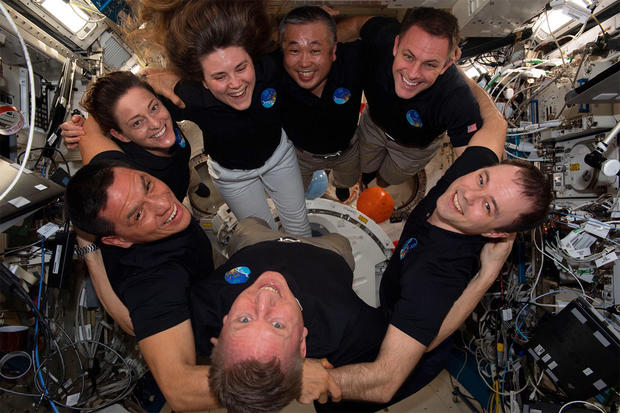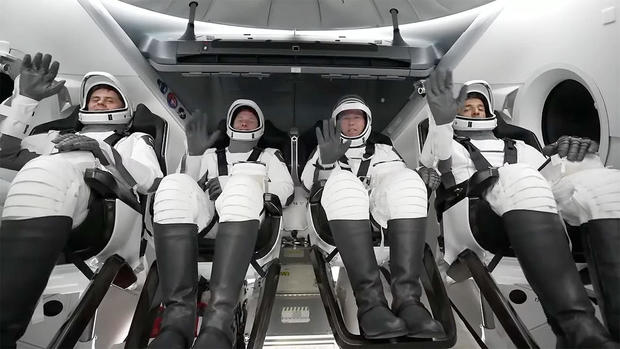SpaceX launches two NASA astronauts, a cosmonaut and an Emerati on flight to space station

Two NASA astronauts, a Russian cosmonaut and an Emerati — the first Arab assigned to a long-duration spaceflight — blasted off atop a SpaceX Falcon 9 rocket early Thursday, lighting up the overnight sky as they set off after the International Space Station.
With Crew-6 commander Stephen Bowen and Warren “Woody” Hoburg monitoring cockpit computer displays, flanked by cosmonaut Andrey Fedyaev and United Arab Emirate flier Sultan Alneyadi, the Falcon 9’s first stage engines ignited with a torrent of fire 12:34 a.m. EST.
NASA TV
After throttling up to a full 1.7 million pounds of thrust, the slender rocket climbed smoothly away from pad 39A at the Kennedy Space Center atop a brilliant jet of flaming exhaust, arcing away to the northeast on a trajectory matching the space station’s orbital path.
The sky-lighting ascent came three days after a last-minute problem with the Falcon 9’s engine ignition system derailed a Monday launch attempt two-and-a-half minutes before liftoff.
Engineers replaced a suspect filter and the second time around, the countdown ticked to zero without a hitch. Nine minutes after reaching orbit, the Falcon 9’s second stage released the Crew Dragon “Endeavour” to fly on its own.
If all goes well, the spacecraft will carry out an automated daylong rendezvous, approaching from behind and below before looping up in front of the space station and then above it, moving in for docking at the Harmony module’s space-facing port at 1:17 a.m.
SpaceX
Bowen and company will be welcomed aboard by Crew-5 commander Nicole Mann, Josh Cassada, Japanese astronaut Koichi Wakata and cosmonaut Anna Kikina, the first Russian to launch aboard a Crew Dragon.
Also welcoming the Crew-6 fliers: Sergey Prokopyev, Dmitri Petelin and NASA astronaut Frank Rubio. They launched to the lab last September and originally planned to fly home in March.
But their Soyuz MS-22 ferry ship was crippled December 14 when a presumed micrometeoroid ruptured a coolant line. After an analysis, Russian engineers concluded the spacecraft could not safely be used again because of the possibility sensitive systems could overheat.
NASA
Instead, a replacement Soyuz — MS-23 — was launched last Thursday, carrying equipment and supplies instead of a crew. The spacecraft successfully docked with the station Saturday night, providing Prokopyev and his crewmates with a safe ride home.
But to get the crew rotation schedule back on track, the trio will have to spend an additional six months in space, coming home this fall after a full year in orbit.
In contrast, the SpaceX Crew-5 and Crew-6 expeditions are proceeding as originally planned with Bowen and company replacing Mann, Cassada, Wakata and Kikina, who were launched to the space station last October.
After briefing their replacements on the intricacies of station operations, Mann and her Crew-5 team will undock and return to Earth around March 9 to close out a 154-day mission. Bowen’s crew plans to stay up until late August.
Fedyaev is the second Russian cosmonaut named to a NASA-sponsored SpaceX Crew Dragon flight while Alneyadi is the second UAE astronaut to fly in space. A countryman, Hazzaa Al Mansoori, visited the space station as part of an earlier Russian Soyuz visit. But Alneyadi is the first Arab to make a long-duration space flight.
NASA TV
Perhaps not widely known in the United States, the UAE “is running a quite interesting number of activities,” Alneyadi said in a pre-launch interview with CBS News. “We have satellites, we have a probe that is orbiting Mars, we have a lander on its way to the lunar surface.
“My colleague, Hazzaa Al Mansoori, and two additional astronauts are training here (at the) Johnson Space Center for future missions. Being an astronaut myself for Crew 6, it’s a great privilege and great responsibility.”
But that doesn’t mean he won’t take a break every now and then to look at the window or have a bit of fun.
An expert in the Japanese martial art of jiu-jitsu, “I have a kimono that I’m going to wear on board and probably do some moves,” he said. He also plans to share one of his favorite foods with his crewmates.
“I love dates, I’m going to take dates. And hopefully I’m going to share this with everybody, especially in Ramadan. This is a request from the commander, and I cannot say no to my commander!”
Bowen, Alneyadi and Fedyaev are all family men, with 13 children between them. Bowen has three, the oldest 26, Alneyadi has six, ages 12 to 3 months, and Fedyaev has four boys.
“They’re still pretty young, so there are things that they don’t really fully understand,” Fedyaev told CBS, speaking through an interpreter. “As for my wife, yes, she is somewhat nervous. But I think that it’s my mom who is the most nervous. I try to tell her not to be that nervous, that everything (will) be okay.”
Said Alneyadi: “Being away from the family, from your kids, I think it’s gonna be tough. Luckily, we have the (ability) to keep that bond going: We have the ability to send emails, to talk with them, to have video calls with them.
“But I think they are the most important element in this. And I think they understand the importance of this mission to me, personally, and to the country. Without their support, without their help, I don’t think this would have been possible.”
Bowen is a former Navy submariner and veteran of three space shuttle flights while his crewmates are space rookies. Bowen said even though his three children have grown up and moved out into the world on their own, “we had a family meeting” before he accepted the Crew 6 assignment.
“I had the whole family together and we discussed very much these issues as to, you know, the risks,” he said. “The most important thing to me is my family. And so anytime I do anything, they are a part of that decision process.”
Share this news on your Fb,Twitter and Whatsapp
Times News Network:Latest News Headlines
Times News Network||Health||New York||USA News||Technology||World News




